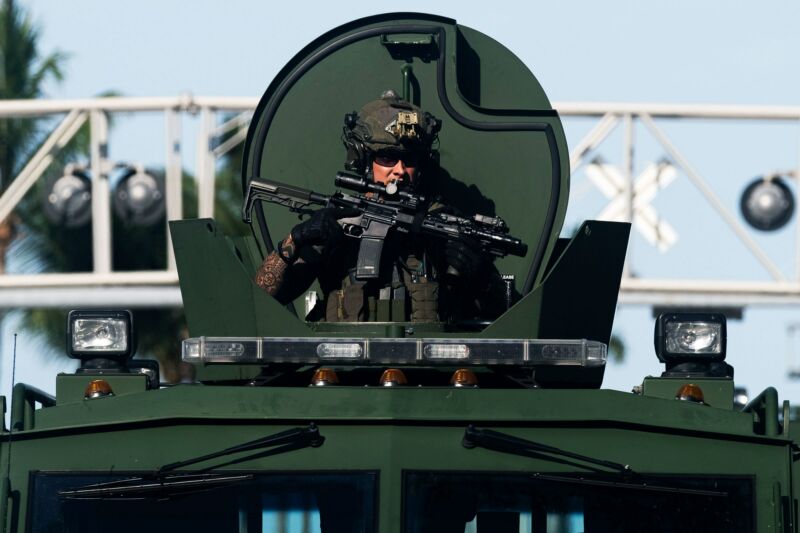The Pentagon’s Hand-Me-Downs Helped Militarize Police. Here’s How.

The images of this past week are both inescapable and indelible: protesters flooding the streets of cities across the United States, met by police forces equipped with full body armor and tactical vehicles that vaguely resemble tanks. The local law enforcement responding to even nonviolent protests has often looked more like the US Armed Forces—and that was before President Donald Trump deployed an actual military police battalion against peaceably assembled US citizens in the nation’s capitol Monday. That’s no accident.
It’s easy enough to buy tactical gear in the US, and the Homeland Security Grant Program has funneled billions of dollars to law enforcement agencies to acquire military-grade equipment. But for decades, a primary driver for why it can be so hard to tell a National Guard troop from a local cop has been the Department of Defense itself, through a program that has parceled out everything from bayonets to grenade launchers to precincts across the country.
Created as part of 1997’s National Defense Authorization Act, the 1033 program allows the Department of Defense to get rid of excess equipment by passing it off to local authorities, who only have to pay for the cost of shipping. (A precursor, the slightly more restrictive 1208 program, began in 1990.) According to the Law Enforcement Support Office (LESO), which oversees the process, over $7.4 billion of property has been transferred since the program’s inception; more than 8,000 law enforcement agencies have enrolled. Much of that inventory is perfectly ordinary: office equipment, clothing, tools, radios, and so on. But the haul also includes some of the so-called controlled equipment—rifles, armored vehicles, and so on—that have helped create such a spectacle of disproportion.
 Those displays are not unique to the current protests against police brutality, either. The militarization of the American police, and the 1033 program specifically, began attracting wider scrutiny in 2014, after the Black Lives Matter protests in Ferguson, Missouri.
Those displays are not unique to the current protests against police brutality, either. The militarization of the American police, and the 1033 program specifically, began attracting wider scrutiny in 2014, after the Black Lives Matter protests in Ferguson, Missouri.
Proponents of the 1033 program say that it keeps cities safer. Detractors say the distribution of controlled items actually increases police violence. Widely circulated studies have argued both sides. But those who have examined the 1033 program in depth more recently argue that the real problem is that no one knows for sure either way, because years of lax record-keeping have made a hash of the underlying data.
“The federal government doesn’t really keep track of a lot of this equipment that goes to local law enforcement agencies,” says Anna Gunderson, a political scientist at Louisiana State University who coauthored a 2019 study that examined the effects of the 1033 program on crime rates. “The agencies themselves are inconsistent in keeping track. That just makes it really difficult for anyone to try to learn about the program or study it to try and analyze it, because we don’t have a very clear understanding what kinds of equipment actually are in the hands of these agencies.”
The LESO does maintain a spreadsheet detailing to whom it has distributed property over the years. When asked about complaints of inconsistent records, a spokesperson for the Defense Logistics Agency, which oversees LESO, noted that the agency changed accounting systems in 2013 to allow state coordinators and law enforcement agencies to identify and track what they receive. That switch, and spotty record-keeping beforehand, has confounded efforts to understand the impact of a program that has helped transform law enforcement in America.
“The DLA did not archive active inventories prior to 2014. They also did not archive information about transfers of equipment and destruction of controlled equipment during that time. LEAs themselves typically only retain records for a few years, subject to their own local-level record keeping requirements,” says Kenneth Lowande, a political scientist at the University of Michigan whose research includes the 1033 program. “Some of this can never be fixed. You can’t recreate records that are lost.”
The issues with 1033 have also run deeper than just contradictory or incomplete data sets. The Department of Defense does not provide training for law enforcement agencies that receive controlled property. Instead, it’s left to recipients to certify their own training each year. “What programs like 1033 have done is given people the equipment to carry out operations that are traditionally done by tactical teams that otherwise would not have been able to obtain it,” says Jonathan Mummolo, a political scientist at Princeton University who focuses on policing. “That is for sure not always accompanied by extensive training. There’s just a lot of variation in policing standards across the board.”
That seemingly lax oversight has manifested in other troubling ways, as well. In a 2017 sting operation, the General Accountability Office obtained over 100 controlled items from the 1033 program—including night-vision goggles and pipe bomb materials—with a total estimated value of $1.2 million. All it took was the creation of a fake law enforcement agency, website, and shipping address. The GAO’s fraudulent application was processed and approved within a week.
The DLA implemented additional controls in the wake of the report, which focused on the acquisition process for federal law enforcement agencies rather than state and local. Those steps include a review of each existing applicant and establishing a point of contact at each federal agency to vet and approve requests. But the GAO’s success in hoodwinking the agency did not inspire confidence. Nor has it inspired the federal government to fundamentally reconsider the premise of distributing controlled equipment to police in the first place.
A year after Ferguson, then president Barack Obama signed an executive order that prohibited state and local law enforcement from receiving certain types of property, like grenade launchers and weaponized aircraft, under the 1033 program, but these restrictions were short-lived: Trump lifted them in 2017. Lowande argues the actual impact of that revocation has been negligible. Obama’s original executive order ultimately only applied to around 300 departments, he says, and there’s no sign in recent DLA inventories that previously restricted items have been sent out again. In a working paper currently under review, Lowande finds that the demilitarization efforts that did take place in those two years showed “no detectable impact on violent crime or officer safety.”
“There is no compelling evidence, right now, that arming LEAs with military-grade equipment increases or decreases crime,” he says.
Other research into the 1033 program, though, paints an alarming picture about its effect on police activity. “Our research suggests that officers with military hardware and mindsets will resort to violence more quickly and often,” says Ryan Welch, a political scientist at the University of Tampa who coauthored a 2017 study on the effects of the 1033 program on police violence. “Other research shows that when governmental responses are violent, dissidents and protestors are more likely to act violently at the site and in the future. Of course, that leads to more violence from the government creating a spiral that is hard to escape.”
In 2018, Princeton’s Mummolo published research showing not only that special weapons and tactics teams are deployed more often in communities of color, but that they on average “provide no detectable benefits in terms of officer safety or violent crime reduction.” Which is a point that often gets lost: While the high-profile responses to police brutality demonstrations draw more attention to the 1033 program and others like it, in many parts of the country its impacts are a staple of policing.
“We tend to focus on these events when there’s massive social unrest and they’re dominating the headlines and we see militarized police come in, but militarized police are active in this country all the time,” says Mummolo. “It doesn’t take a situation like we’re seeing right now to activate them.”
This story originally appeared on wired.com.
READ MORE HERE


